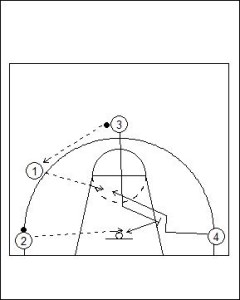Two Ball Screen and Roll Drill
The Two Ball Screen and Roll Drill provides a very good scenario for practicing one of the poorest tactical elements performed by screeners; Rolling to the basket. All too often in basketball games many advantageous situations go wanting because a screener fails to roll to the basket and fully exhaust the options available.
One of the best points about the Two Ball Screen and Roll Drill is it involves multiple options for variations within the drill. Screening areas can be varied to the specific need to the team’s offense and possible problem areas. The principle of the screener rolling and the cutter moving into space remain the same and constant throughout all the possible options available when using the drill.
There are two offensive players involved in the Two Ball Screen and Roll Drill. Both players can have specific technical and tactical focus points changed to build a wide range of skills and strategies.

For the cutter (Four) there are a number of different options to be utilised in the player cutting off the screen. These include:
- Straight Cut
- Curl Cut
- Flare Cut
- Fade Cut
- Hedging over, and then go under the screen
- Re-positioning of the screen
Some of the options for the cutter (Four) will of course change depending on where the screening action takes place. A coach should think about these options before implementing the Two Ball Screen and Roll Drill so all of the necessary variations are covered to meet the needs of the team’s offense.
For the screener likewise there are a number of different options possible for where the screener can move to after the cutter has utilised the screen. Similarly to those used by the cutter, the screen (Three) can:
- Screen and Roll to the basket
- Fake to set the screen and then dive to the basket
- Screen and Flare
- Screen and Fade
All of these options should be explored by a coach when using the Two Ball Screen and Roll Drill and then incorporated into more game realistic (live) and free flowing offensive situations. By doing this a coach will provide for their players the best possible opportunity for success.
As a point of note the Two Ball Screen and Roll Drill is just as important to senior teams as it is for junior players looking to first understand and use these tactical movements. Senior players need to constantly reinforce these options so they are can be reminded of the options available to them and add depth to their offensive output.
The Two Ball Screen and Roll Drill is set-up with lines behind each of the positions diagrammed.
Three (3) passes ball to One (1). Player then cuts through key to set down screen.
Four (4) cuts over screen. One (1) looks to make a pass them by to the cutter.
Three (3) then rolls to basket for a pass from Two (2).
Point of Emphasis:
- Game pace; slow to fast will be the key teaching point. Players should move to the screening area slow, before cutting and rolling at pace
- Correct screening technique and cues; hand signals should be used by the screener when setting the screen. The cutter must wait until the screen is stationary
- Be a good receiving target; cutter and screener must carry their hands and show where they want to pass to be made to
- Lead with the pass; passes must be out in front of the cutters so they have an opportunity to run onto the pass
An extension of the Two Ball Screen and Roll Drill is to add two defenders to the activity. This should be used as an extension and not a starting point. Even competent players should use the Two Ball Screen and Roll Drill as an opportunity to refine and define their technique.







